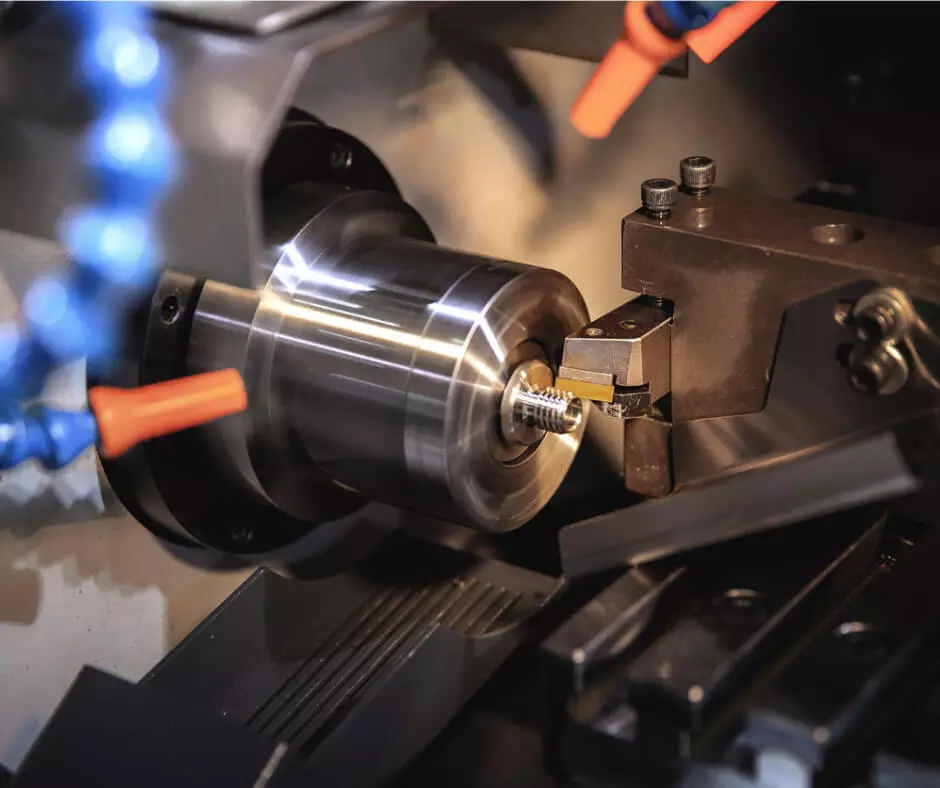
ROBOTIC CELLS FOR CNC SUBSERVIENCE
Robotic cells for CNC subservience are created with the aim of maximizing the efficiency of CNC machine tools and optimizing the production flow, thus obtaining better performances.
But what exactly do robotic cells do in this field? And how can industrial robotics help men in their tasks?
CNC machines
CNC (computerized numerical control) machines perform processes in which there is an automated removal of metal or plastic material from an initial block to arrive at a finished product.
In order to do this, the machine is controlled by a computer-controller according to a custom code, also known as 'G-code', which is a list of coordinates that guide the mechanical operations of the tools. All machines whose machining is controlled by this code are definable as CNC machines.
A CNC machine, therefore, can mainly perform two operations:
- Milling: This operation is carried out by rotary cutting. The milling cutter's tools move on multiple axes to allow for the proper removal of desired material to arrive at the finished product, which can range from simple to very complex shapes.
- Turning: operation performed by a motorized lathe that penetrates a metal bar to produce products with cylindrical features, holes (housing, radial or axial) and grooves
Various types of metals (e.g. aluminum, steel, copper), alloys and plastics can be processed and there are many industrial sectors that make use of this type of processing, also known as subctractive manufacturing, for example:
- Fashion accessories (e.g. shooting pieces)
- Medical
- Aviation
- Aerospace
- Mechanics
- Automotive
- Consumer electronics
- Faucets
Operators, industrial robotics and CNC machining
In a company that uses robotic cells for CNC subservience in it’s production line, the operator has the important job to set the processing programs, load the machine’s hopper with the work pieces, check that everything’s working correctly and pick the products from the collection area when the process is finished. Therefore, these tasks are very different from the fixed position at the lathe or milling machine.
The anthropomorphic robot, on the other hand, is programmed to carry out the task of loading/unloading the parts to be machined, which can be of various sizes and allocated on vices in mono-machining mode (same machining on several vices) and multi-machining mode (several machining operations on several vices).
But which, exactly is the process that the industrial robot executes inside the cell?
It starts by picking up the blank part (or more than one) from the feeding system, then places it on a zeroing template. It then picks up the part again and loads it into the vise of the CNC machine, which is ready to begin machining. When the part is machined, the robot retrieves it from the vise and deposits it in the collection area. This generates an automated assembly line through coordinated and rapid movements.
Usually, the cell is equipped with a 2D and 3D vision system with Infrared backlighting that allows the robot to "detect" and "recognize" raw parts on the reflective surface of the feed belt.
The robot is equipped with gripping systems with several grippers capable of handling several parts (raw/machined) at the same time and with a blowing system to eliminate any processing waste.
This type of industrial automation is particularly suitable for those companies that must produce large batches in which the pieces must undergo the same processing for long periods of time.
In this process, the operator only has to deal with setting the program, loading the pieces to be processed into the hopper and taking the processed pieces back from the collection area once the batch processing has been completed. Finally, the operator can also supervise the process, but is not required to be continuously present in front of the cell controller: he can devote himself to other more qualified activities and intervene only when the need arises.
The advantages of robotic cells for CNC subservience
The concrete advantages that a robotic cell for CNC servicing can bring to a company are:
- increase in production
- Autonomous machining up to 96 hours, depending on hopper capacity and workpiece collection area
- Payback in less that a year
- High levels of precision and flexibility
- Safe and healthy work place for the employees
- 24/7 availability
- Consistent quality standards overtime and shift duration
FIND OUT HOW MUCH A ROBOTIC CELL WOULD COST TO YOUR COMPANY WITH OUR ONLINE CONFIGURATOR
Tera Automation’s robotic cell for CNC subservience
In our industrial automation line, inside Tera Automation we created T-Flexicell™ a robotic cell dedicated to manage the loading/unloading of semi-finished products or blanks of various shapes and sizes.
At the heart of this industrial robotics automation are the T-Loop Feeder™ and T-Rotofeeder™ feeding systems. Let's look at them in detail. T-Loop Feeder™ is a patented system and is a parallel belt conveyor with opposing motion for feeding raw parts. Different is T-Rotofeeder™, a 'revolver' feeding system: a rotating multi-column pick-up magazine for loading unmachined parts destined for machining.
At the discretion of the customer and their needs, either power system can be integrated.
The robotic cell for CNC subservience can also be equipped with a system for acquiring production data, storing them and administering them (JARVIS, owned by Tera Automation) in order to obtain a more intelligent management of the machine. This software relies on T-Router™, which also allows the resolution of possible problems and remote control of the cell.
In addition, control cameras can be installed to keep the entire process under constant observation, even from smartphones.



